Yamaha XVS1300A Y 2009 Owner's manual
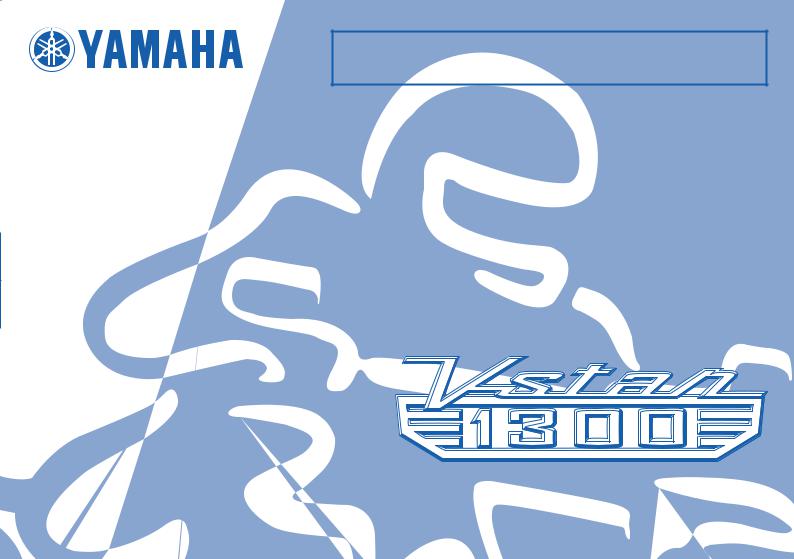
 Read this manual carefully before operating this vehicle.
Read this manual carefully before operating this vehicle.
OWNER’S MANUAL
XVS1300AY
12C-28199-22

EAU46090
 Read this manual carefully before operating this vehicle. This manual should stay with this vehicle if it is sold.
Read this manual carefully before operating this vehicle. This manual should stay with this vehicle if it is sold.
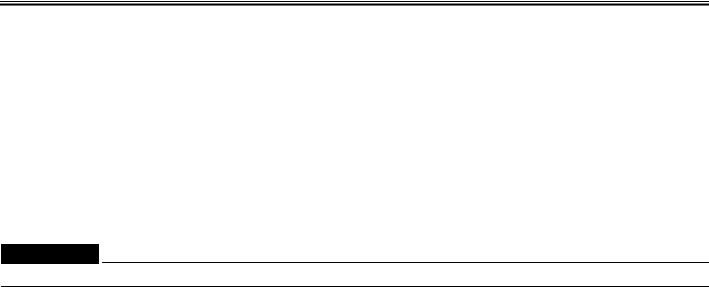
INTRODUCTION
EAU10102
Welcome to the Yamaha world of motorcycling!
As the owner of the XVS1300AY, you are benefiting from Yamaha’s vast experience and newest technology regarding the design and manufacture of high-quality products, which have earned Yamaha a reputation for dependability.
Please take the time to read this manual thoroughly, so as to enjoy all advantages of your XVS1300AY. The Owner’s Manual does not only instruct you in how to operate, inspect and maintain your motorcycle, but also in how to safeguard yourself and others from trouble and injury.
In addition, the many tips given in this manual will help keep your motorcycle in the best possible condition. If you have any further questions, do not hesitate to contact your Yamaha dealer.
The Yamaha team wishes you many safe and pleasant rides. So, remember to put safety first!
Yamaha continually seeks advancements in product design and quality. Therefore, while this manual contains the most current product information available at the time of printing, there may be minor discrepancies between your motorcycle and this manual. If there is any question concerning this manual, please consult a Yamaha dealer.
EWA10031
 WARNING
WARNING
Please read this manual carefully and completely before operating this motorcycle.

IMPORTANT MANUAL INFORMATION
EAU10132
Particularly important information is distinguished in this manual by the following notations:
This is the safety alert symbol. It is used to alert you to potential personal injury hazards. Obey all safety messages that follow this symbol to avoid possible injury or death.
WARNING |
A WARNING indicates a hazardous situation which, if not avoided, could result in |
|
death or serious injury. |
||
|
||
NOTICE |
A NOTICE indicates special precautions that must be taken to avoid damage to the |
|
vehicle or other property. |
||
|
TIP |
A TIP provides key information to make procedures easier or clearer. |
|
|

IMPORTANT MANUAL INFORMATION
EAU10200
XVS1300AY
OWNER’S MANUAL ©2008 by Yamaha Motor Co., Ltd.
1st edition, October 2008 All rights reserved.
Any reprinting or unauthorized use without the written permission of Yamaha Motor Co., Ltd.
is expressly prohibited. Printed in Japan.

TABLE OF CONTENTS
LOCATION OF IMPORTANT |
|
FOR YOUR SAFETY – |
|
Adjusting the clutch lever free |
|
LABELS ............................................. |
1-1 |
PRE-OPERATION CHECKS ............. |
5-1 |
play ........................................... |
7-16 |
|
|
|
|
Adjusting the brake lever free |
|
SAFETY INFORMATION .................. |
2-1 |
OPERATION AND IMPORTANT |
|
play ........................................... |
7-17 |
|
|
RIDING POINTS................................. |
6-1 |
Adjusting the rear brake light |
|
DESCRIPTION .................................. |
3-1 |
Starting the engine ......................... |
6-1 |
switch ....................................... |
7-18 |
Left view .......................................... |
3-1 |
Shifting ........................................... |
6-2 |
Checking the front and rear brake |
|
Right view ........................................ |
3-2 |
Tips for reducing fuel |
|
pads .......................................... |
7-18 |
Controls and instruments................. |
3-3 |
consumption ............................... |
6-3 |
Checking the brake fluid level ...... |
7-19 |
|
|
Engine break-in .............................. |
6-3 |
Changing the brake fluid .............. |
7-20 |
INSTRUMENT AND CONTROL |
|
Parking ........................................... |
6-4 |
Drive belt slack ............................ |
7-20 |
FUNCTIONS ....................................... |
4-1 |
|
|
Checking and lubricating |
|
Immobilizer system ......................... |
4-1 |
PERIODIC MAINTENANCE AND |
|
the cables ................................. |
7-21 |
Main switch/steering lock ................ |
4-2 |
ADJUSTMENT ................................... |
7-1 |
Checking and lubricating |
|
Indicator and warning lights ............ |
4-4 |
Owner’s tool kit ............................... |
7-1 |
the throttle grip and cable ......... |
7-21 |
Multi-function meter unit ................. |
4-6 |
Periodic maintenance chart for the |
|
Checking and lubricating |
|
Handlebar switches ........................ |
4-9 |
emission control system ............. |
7-2 |
the brake and shift pedals ........ |
7-22 |
Clutch lever ................................... |
4-11 |
General maintenance and |
|
Checking and lubricating |
|
Shift pedal ..................................... |
4-11 |
lubrication chart .......................... |
7-3 |
the brake and clutch levers ...... |
7-22 |
Brake lever ................................... |
4-11 |
Removing and installing |
|
Checking and lubricating |
|
Brake pedal .................................. |
4-12 |
the panel ..................................... |
7-7 |
the sidestand ............................ |
7-23 |
Fuel tank cap ................................ |
4-12 |
Checking the spark plugs ............... |
7-7 |
Lubricating the swingarm |
|
Fuel ............................................... |
4-13 |
Engine oil and oil filter cartridge ..... |
7-9 |
pivots ........................................ |
7-23 |
Catalytic converter ........................ |
4-14 |
Coolant ......................................... |
7-12 |
Lubricating the rear suspension ... |
7-24 |
Rider seat ..................................... |
4-15 |
Replacing the air filter element ..... |
7-13 |
Checking the front fork ................. |
7-24 |
Helmet holder ............................... |
4-15 |
Checking the throttle cable free |
|
Checking the steering .................. |
7-25 |
Adjusting the shock absorber |
|
play ........................................... |
7-14 |
Checking the wheel bearings ....... |
7-25 |
assembly ................................... |
4-16 |
Valve clearance ............................ |
7-14 |
Battery ......................................... |
7-25 |
Sidestand ...................................... |
4-17 |
Tires ............................................. |
7-14 |
Replacing the fuses ..................... |
7-27 |
Ignition circuit cut-off system ........ |
4-18 |
Cast wheels .................................. |
7-16 |
Replacing the headlight bulb ....... |
7-28 |

TABLE OF CONTENTS
Replacing the tail/brake light |
|
bulb ........................................... |
7-30 |
Replacing a turn signal light |
|
bulb ........................................... |
7-30 |
Replacing the license plate light |
|
bulb ........................................... |
7-30 |
Replacing the auxiliary light |
|
bulb ........................................... |
7-31 |
Supporting the motorcycle ............ |
7-32 |
Troubleshooting ............................ |
7-33 |
Troubleshooting charts ................. |
7-34 |
MOTORCYCLE CARE AND |
|
STORAGE .......................................... |
8-1 |
Matte color caution ......................... |
8-1 |
Care ................................................ |
8-1 |
Storage ........................................... |
8-3 |
SPECIFICATIONS ............................. |
9-1 |
CONSUMER INFORMATION........... |
10-1 |
Identification numbers .................. |
10-1 |
Motorcycle noise regulation |
|
(for Australia) ............................ |
10-2 |
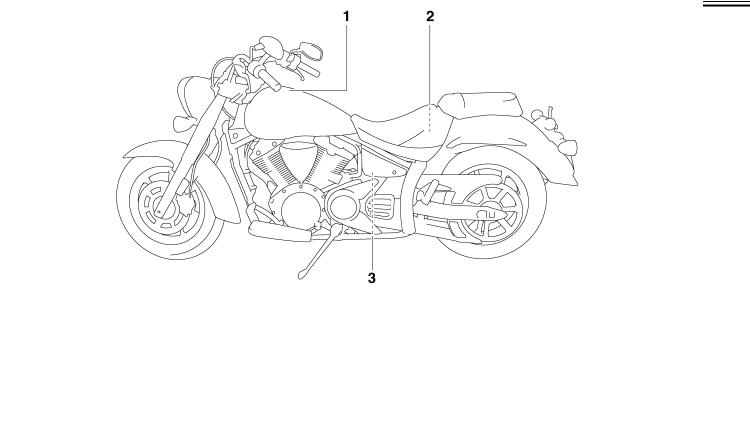
LOCATION OF IMPORTANT LABELS
EAU10383
Read and understand all of the labels on your vehicle. They contain important information for safe and proper operation of
1your vehicle. Never remove any labels from your vehicle. If a label becomes difficult to read or comes off, a replacement label is available from your Yamaha dealer.
1-1
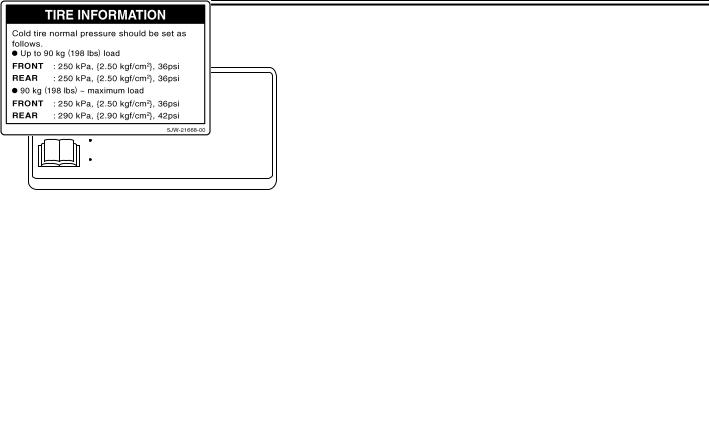
LOCATION OF IMPORTANT LABELS
1 |
|
3 |
|
1 |
|
|
|
Before you operate this vehicle, |
|
|
|
|
|
|
|
|
|
|
|
read the owner’s manual. |
|
|
|
|
|
Prima di usare il veicolo, |
|
|
|
|
|
leggete il manuale di istruzioni. |
|
|
|
|
|
Lire le manuel du propriétaire |
|
|
|
|
|
avant d’utiliser ce véhicule. |
|
|
|
|
|
Lesen Sie die Bedienungsanleitung |
|
|
|
|
|
bevor Sie dieses Fahrzeug fahren. |
|
|
|
|
|
Antes de conducir este vehículo, |
|
|
|
|
|
lea el Manual del Propietario. |
|
|
|
|
|
5RU-21568-01 |
|
|
|
2
Cold tire normal pressure should be set as follows.
280 |
|
2.80 |
|
41 |
|
|
|
|
|
280 |
2.80 |
41 |
1D7-21668-00
1-2

 SAFETY INFORMATION
SAFETY INFORMATION
EAU10283
Be a Responsible Owner
As the vehicle’s owner, you are responsible for the safe and proper operation
2of your motorcycle.
Motorcycles are single-track vehicles. Their safe use and operation are dependent upon the use of proper riding techniques as well as the expertise of the operator. Every operator should know the following requirements before riding this motorcycle.
He or she should:
●Obtain thorough instructions from a competent source on all aspects of motorcycle operation.
●Observe the warnings and maintenance requirements in this Owner’s Manual.
●Obtain qualified training in safe and proper riding techniques.
●Obtain professional technical service as indicated in this Owner’s Manual and/or when made necessary by mechanical conditions.
Safe Riding
Perform the pre-operation checks each time you use the vehicle to make sure it is in safe operating condition. Failure to inspect or maintain the vehicle properly increases the possibility of an accident or equipment damage. See page 5-1 for a list of pre-operation checks.
●This motorcycle is designed to carry the operator and a passenger.
●The failure of motorists to detect and recognize motorcycles in traffic is the predominating cause of automobile/motorcycle accidents. Many accidents have been caused by an automobile driver who did not see the motorcycle. Making yourself conspicuous appears to be very effective in reducing the chance of this type of accident.
Therefore:
•Wear a brightly colored jacket.
•Use extra caution when you are approaching and passing through intersections, since intersections are the most likely places for motorcycle accidents to occur.
•Ride where other motorists can see you. Avoid riding in another motorist’s blind spot.
●Many accidents involve inexperienced operators. In fact, many operators who have been involved in accidents do not even have a current motorcycle license.
•Make sure that you are qualified and that you only lend your motorcycle to other qualified operators.
•Know your skills and limits. Staying within your limits may help you to avoid an accident.
•We recommend that you practice riding your motorcycle where there is no traffic until you have become thoroughly familiar with the motorcycle and all of its controls.
●Many accidents have been caused by error of the motorcycle operator. A typical error made by the operator is veering wide on a turn
2-1

 SAFETY INFORMATION
SAFETY INFORMATION
due to excessive speed or undercornering (insufficient lean angle for the speed).
•Always obey the speed limit and never travel faster than warranted by road and traffic conditions.
•Always signal before turning or changing lanes. Make sure that other motorists can see you.
●The posture of the operator and passenger is important for proper control.
•The operator should keep both hands on the handlebar and both feet on the operator footrests during operation to maintain control of the motorcycle.
•The passenger should always hold onto the operator, the seat strap or grab bar, if equipped, with both hands and keep both feet on the passenger footrests. Never carry a passenger unless he or she can firmly place both feet on the passenger footrests.
●Never ride under the influence of alcohol or other drugs.
●This motorcycle is designed for onroad use only. It is not suitable for off-road use.
Protective apparel
The majority of fatalities from motorcycle accidents are the result of head injuries. The use of a safety helmet is the single most critical factor in the prevention or reduction of head injuries.
●Always wear an approved helmet.
●Wear a face shield or goggles. Wind in your unprotected eyes could contribute to an impairment of vision that could delay seeing a hazard.
●The use of a jacket, heavy boots, trousers, gloves, etc., is effective in preventing or reducing abrasions or lacerations.
●Never wear loose-fitting clothes, otherwise they could catch on the control levers, footrests, or wheels and cause injury or an accident.
●Always wear protective clothing that covers your legs, ankles, and feet. The engine or exhaust system become very hot during or after operation and can cause burns.
2-2
●A passenger should also observe the above precautions.
Avoid Carbon Monoxide Poisoning
All engine exhaust contains carbon monoxide, a deadly gas. Breathing car- 2 bon monoxide can cause headaches, dizziness, drowsiness, nausea, confusion, and eventually death.
Carbon Monoxide is a colorless, odorless, tasteless gas which may be present even if you do not see or smell any engine exhaust. Deadly levels of carbon monoxide can collect rapidly and you can quickly be overcome and unable to save yourself. Also, deadly levels of carbon monoxide can linger for hours or days in enclosed or poorly ventilated areas. If you experience any symptoms of carbon monoxide poisoning, leave the area immediately, get fresh air, and SEEK MEDICAL TREATMENT.
●Do not run engine indoors. Even if you try to ventilate engine exhaust with fans or open windows and doors, carbon monoxide can rapidly reach dangerous levels.

 SAFETY INFORMATION
SAFETY INFORMATION
●Do not run engine in poorly ventilated or partially enclosed areas such as barns, garages, or carports.
●Do not run engine outdoors where
2engine exhaust can be drawn into a building through openings such as windows and doors.
Loading
Adding accessories or cargo to your motorcycle can adversely affect stability and handling if the weight distribution of the motorcycle is changed. To avoid the possibility of an accident, use extreme caution when adding cargo or accessories to your motorcycle. Use extra care when riding a motorcycle that has added cargo or accessories. Here, along with the information about accessories below, are some general guidelines to follow if loading cargo to your motorcycle:
The total weight of the operator, passenger, accessories and cargo must not exceed the maximum load limit.
Operation of an overloaded vehicle could cause an accident.
Maximum load:
210 kg (463 lb)
When loading within this weight limit, keep the following in mind:
●Cargo and accessory weight should be kept as low and close to the motorcycle as possible. Securely pack your heaviest items as close to the center of the vehicle as possible and make sure to distribute the weight as evenly as possible on both sides of the motorcycle to minimize imbalance or instability.
●Shifting weights can create a sudden imbalance. Make sure that accessories and cargo are securely attached to the motorcycle before riding. Check accessory mounts and cargo restraints frequently.
•Properly adjust the suspension for your load (suspension-ad- justable models only), and check the condition and pressure of your tires.
•Never attach any large or heavy items to the handlebar, front fork, or front fender. These
2-3
items, including such cargo as sleeping bags, duffel bags, or tents, can create unstable handling or a slow steering response.
●This vehicle is not designed to pull a trailer or to be attached to a sidecar.
Genuine Yamaha Accessories
Choosing accessories for your vehicle is an important decision. Genuine Yamaha accessories, which are available only from a Yamaha dealer, have been designed, tested, and approved by Yamaha for use on your vehicle.
Many companies with no connection to Yamaha manufacture parts and accessories or offer other modifications for Yamaha vehicles. Yamaha is not in a position to test the products that these aftermarket companies produce. Therefore, Yamaha can neither endorse nor recommend the use of accessories not sold by Yamaha or modifications not specifically recommended by Yamaha, even if sold and installed by a Yamaha dealer.

 SAFETY INFORMATION
SAFETY INFORMATION
Aftermarket Parts, Accessories, and Modifications
While you may find aftermarket products similar in design and quality to genuine Yamaha accessories, recognize that some aftermarket accessories or modifications are not suitable because of potential safety hazards to you or others. Installing aftermarket products or having other modifications performed to your vehicle that change any of the vehicle’s design or operation characteristics can put you and others at greater risk of serious injury or death. You are responsible for injuries related to changes in the vehicle.
Keep the following guidelines in mind, as well as those provided under “Loading” when mounting accessories.
●Never install accessories or carry cargo that would impair the performance of your motorcycle. Carefully inspect the accessory before using it to make sure that it does not in any way reduce ground clearance or cornering clearance,
limit suspension travel, steering travel or control operation, or obscure lights or reflectors.
•Accessories fitted to the handlebar or the front fork area can create instability due to improper weight distribution or aerodynamic changes. If accessories are added to the handlebar or front fork area, they must be as lightweight as possible and should be kept to a minimum.
•Bulky or large accessories may seriously affect the stability of the motorcycle due to aerodynamic effects. Wind may attempt to lift the motorcycle, or the motorcycle may become unstable in cross winds. These accessories may also cause instability when passing or being passed by large vehicles.
•Certain accessories can displace the operator from his or her normal riding position. This improper position limits the freedom of movement of the opera-
tor and may limit control ability, therefore, such accessories are not recommended.
● Use caution when adding electrical accessories. If electrical acces-
sories exceed the capacity of the 2 motorcycle’s electrical system, an electric failure could result, which could cause a dangerous loss of lights or engine power.
Aftermarket Tires and Rims
The tires and rims that came with your motorcycle were designed to match the performance capabilities and to provide the best combination of handling, braking, and comfort. Other tires, rims, sizes, and combinations may not be appropriate. Refer to page 7-14 for tire specifications and more information on replacing your tires.
2-4

DESCRIPTION
EAU10410
Left view
3
1.Front turn signal light (page 7-30)
2.Headlight (page 7-28)
3.Seat lock (page 4-15)
4.Fuel injection system fuse (page 7-27)
5.Fuse box (page 7-27)
6.Main fuse (page 7-27)
7.Helmet holder (page 4-15)
8.License plate light (page 7-30)
9. Rear turn signal light (page 7-30) 10.Engine oil level check window (page 7-9) 11.Shift pedal (page 4-11)
12.Engine oil filler cap (page 7-9)
3-1

DESCRIPTION
EAU10420
Right view
3
1. |
Tail/brake light (page 7-30) |
9. Rear brake light switch (page 7-18) |
2. |
Rear brake fluid reservoir (page 7-19) |
10.Engine oil filter cartridge (page 7-9) |
3. |
Owner’s tool kit (page 7-1) |
11.Engine oil drain bolt (page 7-9) |
4. |
Battery (page 7-25) |
12.Coolant reservoir (page 7-12) |
5. |
Air filter element (page 7-13) |
13.Shock absorber assembly spring preload adjusting ring (page 4-16) |
6.Fuel tank cap (page 4-12)
7.Front brake fluid reservoir (page 7-19)
8.Brake pedal (page 4-12)
3-2
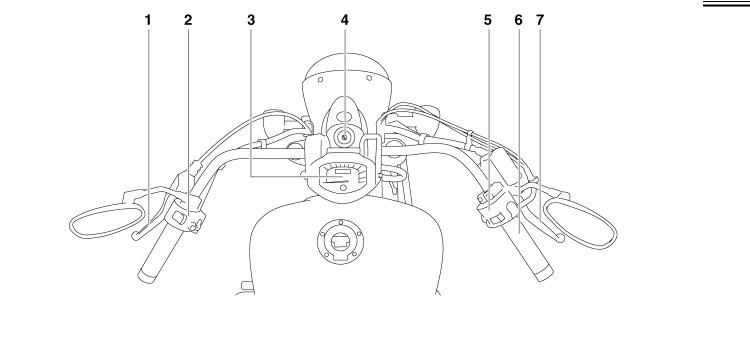
DESCRIPTION
EAU10430
Controls and instruments
3
1.Clutch lever (page 4-11)
2.Left handlebar switches (page 4-9)
3.Multi-function meter unit (page 4-6)
4.Main switch/steering lock (page 4-2)
5.Right handlebar switches (page 4-9)
6.Throttle grip (page 7-14)
7.Brake lever (page 4-11)
3-3

INSTRUMENT AND CONTROL FUNCTIONS
EAU10976
Immobilizer system
1.Code re-registering key (red bow)
2.Standard keys (black bow)
This vehicle is equipped with an immobilizer system to help prevent theft by re-registering codes in the standard keys. This system consists of the following:
●a code re-registering key (with a red bow)
●two standard keys (with a black bow) that can be re-registered with new codes
●a transponder (which is installed in the code re-registering key)
●an immobilizer unit
●an ECU
● an immobilizer system indicator light (See page 4-4.)
The key with the red bow is used to register codes in each standard key. Since re-registering is a difficult process, take the vehicle along with all three keys to a Yamaha dealer to have them re-reg- istered. Do not use the key with the red bow for driving. It should only be used for re-registering the standard keys. Always use a standard key for driving.
ECA11821
NOTICE
●DO NOT LOSE THE CODE REREGISTERING KEY! CONTACT YOUR DEALER IMMEDIATELY IF IT IS LOST! If the code re-reg- istering key is lost, registering new codes in the standard keys is impossible. The standard keys can still be used to start the vehicle, however if code reregistering is required (i.e., if a new standard key is made or all keys are lost) the entire immobilizer system must be replaced. Therefore, it is highly recom-
mended to use either standard key and keep the code re-regis- tering key in a safe place.
●Do not submerse any key in water.
●Do not expose any key to excessively high temperatures.
●Do not place any key close to
magnets (this includes, but not |
|
limited to, products such as |
|
speakers, etc.). |
4 |
●Do not place items that transmit electrical signals close to any key.
●Do not place heavy items on any key.
●Do not grind any key or alter its shape.
●Do not disassemble the plastic part of any key.
●Do not put two keys of any immobilizer system on the same key ring.
●Keep the standard keys as well as keys of other immobilizer systems away from this vehicle’s code re-registering key.
4-1

INSTRUMENT AND CONTROL FUNCTIONS
●Keep other immobilizer system keys away from the main switch as they may cause signal interference.
4
EAU10471
Main switch/steering lock
The main switch/steering lock controls the ignition and lighting systems, and is used to lock the steering.
TIP
Be sure to use the standard key (black bow) for regular use of the vehicle. To minimize the risk of losing the code reregistering key (red bow), keep it in a safe place and only use it for code reregistering.
EAU38530
ON
All electrical circuits are supplied with power; the meter lighting, taillight, license plate light and auxiliary light come on, and the engine can be started. The key cannot be removed.
TIP
The headlight comes on automatically when the engine is started and stays on until the key is turned to “OFF”, even if the engine stalls.
EAU10661
OFF
All electrical systems are off. The key can be removed.
EWA10061
 WARNING
WARNING
Never turn the key to “OFF” or “LOCK” while the vehicle is moving. Otherwise the electrical systems will be switched off, which may result in loss of control or an accident.
4-2
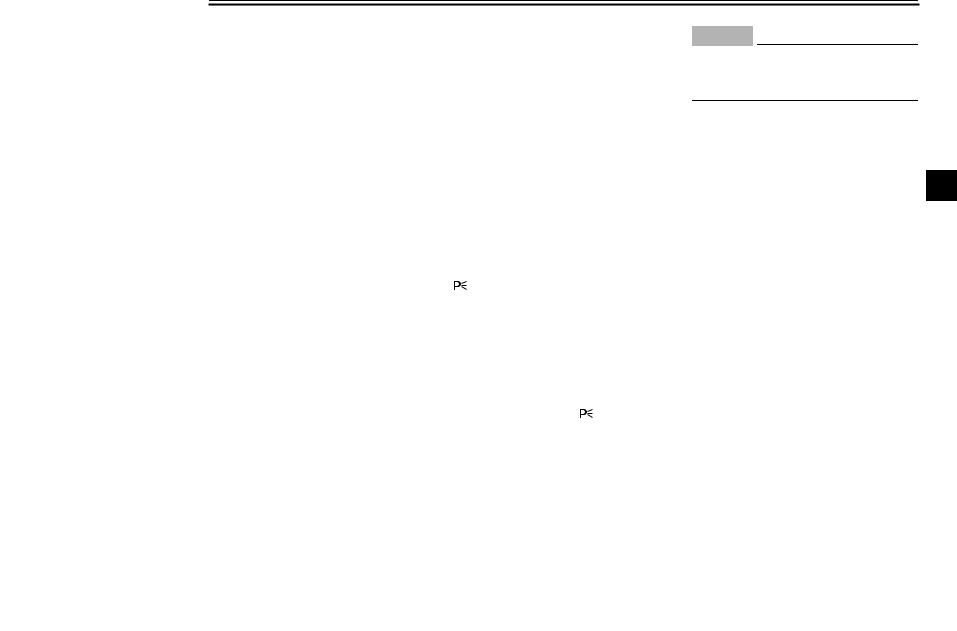
INSTRUMENT AND CONTROL FUNCTIONS
EAU10681 |
To unlock the steering |
LOCK |
|
The steering is locked, and all electrical |
|
systems are off. The key can be re- |
|
moved. |
|
To lock the steering |
|
1. |
Push. |
2. |
Turn. |
|
|
Push the key in, and then turn it to |
|
|
|
“OFF” while still pushing it. |
|
1. |
Push. |
EAU34341 |
|
(Parking) |
|||
2. |
Turn. |
||
The steering is locked, and the taillight, |
|||
|
|
||
1. Turn the handlebars all the way to |
license plate light and auxiliary light are |
||
|
the left. |
on. The hazard lights and turn signal |
|
2.Push the key in from the “OFF” polights can be turned on, but all other sition, and then turn it to “LOCK” electrical systems are off. The key can
while still pushing it. |
be removed. |
3. Remove the key. |
The steering must be locked before the |
|
key can be turned to “ ”. |
ECA11020
NOTICE
Do not use the parking position for an extended length of time, otherwise the battery may discharge.
4
4-3

INSTRUMENT AND CONTROL FUNCTIONS
EAU11003
Indicator and warning lights
4
1.Neutral indicator light “  ”
”
2.Coolant temperature warning light “  ”
”
3.Engine trouble warning light “  ”
”
4.High beam indicator light “  ”
”
5.Turn signal indicator light “ ”
”
6.Oil level warning light “ 

 ”
”
7.Fuel level warning light “ ”
”
8.Immobilizer system indicator light
EAU11020
Turn signal indicator light “ ”
”
This indicator light flashes when the turn signal switch is pushed to the left or right.
EAU11060
Neutral indicator light “ ”
”
This indicator light comes on when the transmission is in the neutral position.
EAU11080
High beam indicator light “ ”
”
This indicator light comes on when the high beam of the headlight is switched on.
EAU11252
Oil level warning light “

 ”
”
This warning light comes on if the engine oil level is low.
The electrical circuit of the warning light can be checked by turning the key to “ON”.
If the warning light does not come on for a few seconds, then go off, have a Yamaha dealer check the electrical circuit.
TIP
●Even if the oil level is sufficient, the warning light may flicker when riding on a slope or during sudden acceleration or deceleration, but this is not a malfunction.
●This model is also equipped with a self-diagnosis device for the oil level detection circuit. If a problem is detected in the oil level detection circuit, the following cycle will be repeated until the malfunction is
corrected: The oil level warning light will flash ten times, then go off for 2.5 seconds. If this occurs, have a Yamaha dealer check the vehicle.
EAU42742
Fuel level warning light “ ”
”
This warning light comes on when the fuel level drops below approximately 3.7 L (0.98 US gal, 0.81 Imp.gal). When this occurs, refuel as soon as possible. The electrical circuit of the warning light can be checked by turning the key to “ON”.
If the warning light does not come on for a few seconds, and then go off, have a Yamaha dealer check the electrical circuit.
TIP
●The vehicle must be on a level surface and positioned upright, otherwise the fuel level warning light may not come on and go off at the appropriate times.
●This model is also equipped with a self-diagnosis device for the fuel level detection circuit. If a problem
4-4

INSTRUMENT AND CONTROL FUNCTIONS
is detected in the fuel level detection circuit, the following cycle will be repeated until the malfunction is corrected: The fuel level warning light will flash eight times, and then go off for 3.0 seconds. If this occurs, have a Yamaha dealer check the vehicle.
EAU11442
Coolant temperature warning light “  ”
”
This warning light comes on if the engine overheats. If this occurs, stop the engine immediately and allow the engine to cool.
The electrical circuit of the warning light can be checked by turning the key to “ON”.
If the warning light does not come on for a few seconds, then go off, have a Yamaha dealer check the electrical circuit.
ECA10021
NOTICE
TIP |
|
|
|
|
EAU38621 |
|
|
|
|
|
|
|
Immobilizer system indicator light |
|
|
|
|
|
|
|
|
|
|
|||
● For radiator-fan-equipped vehi- |
The electrical circuit of the indicator |
|
|
|
||||
|
cles, the radiator fan(s) automati- |
light can be checked by turning the key |
|
|
|
|||
|
cally switch on or off according to |
to “ON”. |
|
|
|
|||
|
the coolant temperature in the ra- |
If the indicator light does not come on |
|
|
|
|||
|
diator. |
for a few seconds, then go off, have a |
|
|
|
|||
● If the engine overheats, see page |
Yamaha dealer check the electrical cir- |
|
|
|
||||
|
7-34 for further instructions. |
cuit. |
|
|
|
|||
|
|
|
|
|
When the key is turned to “OFF” and 30 |
|
|
|
|
|
|
|
|
|
|
|
|
|
|
|
|
|
seconds have passed, the indicator |
|
|
|
|
EAU42772 |
|
4 |
|
||||
Engine trouble warning light “ |
|
” |
light will start flashing indicating the im- |
|
|
|||
|
|
|
|
|||||
This warning light comes on if a prob- |
mobilizer system is enabled. After 24 |
|
|
|
||||
lem is detected in the electrical circuit |
hours have passed, the indicator light |
|
|
|
||||
monitoring the engine. If this occurs, |
will stop flashing, however the immobi- |
|
|
|
||||
have a Yamaha dealer check the self- |
lizer system is still enabled. |
|
|
|
||||
diagnosis system. (See page 4-8 for an |
This model is also equipped with a self- |
|
|
|
||||
explanation of the self-diagnosis de- |
diagnosis device for the immobilizer |
|
|
|
||||
vice.) |
system. (See page 4-8 for an explana- |
|
|
|
||||
The electrical circuit of the warning light |
tion of the self-diagnosis device.) |
|
|
|
||||
can be checked by turning the key to |
|
|
|
|
||||
“ON”. If the warning light does not come |
|
|
|
|
||||
on for a few seconds, then go off, have |
|
|
|
|
||||
a Yamaha dealer check the electrical |
|
|
|
|
||||
circuit. |
|
|
|
|
||||
Do not continue to operate the engine if it is overheating.
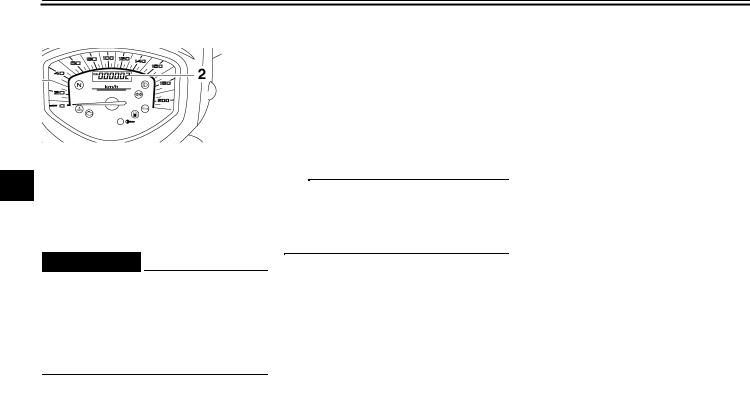
INSTRUMENT AND CONTROL FUNCTIONS
EAU42906
Multi-function meter unit
4
1.Speedometer
2.Odometer/tripmeter/fuel reserve tripmeter/clock
EWA12422
 WARNING
WARNING
Be sure to stop the vehicle before making any setting changes to the multi-function meter unit. Changing settings while riding can distract the operator and increase the risk of an accident.
The multi-function meter unit is equipped with the following:
●a speedometer
●an odometer
●two tripmeters (which show the distance traveled since they were last set to zero)
●a fuel reserve tripmeter (which shows the distance traveled on the fuel reserve)
●a clock
●a self-diagnosis device
●a brightness control mode
TIP
Be sure to turn the key to “ON” before using the “SELECT” switch “ /
/ ” and “RESET” switch, except for setting the brightness control mode.
” and “RESET” switch, except for setting the brightness control mode.
1.“SELECT” switch “ /
/ ”
”
2.“RESET” switch
Speedometer
1. Speedometer
When the key is turned to “ON”, the speedometer needle will sweep once across the speed range and then return to zero in order to test the electrical circuit.
4-6

INSTRUMENT AND CONTROL FUNCTIONS
Odometer, tripmeters, fuel reserve tripmeter and clock
1.Odometer/tripmeter/fuel reserve tripmeter/clock
Push the “ ” side of the “SELECT” switch to switch the display between the odometer mode “ODO”, the tripmeter modes “TRIP 1” and “TRIP 2” and the clock mode in the following order:
” side of the “SELECT” switch to switch the display between the odometer mode “ODO”, the tripmeter modes “TRIP 1” and “TRIP 2” and the clock mode in the following order:
ODO → TRIP 1 → TRIP 2 → Clock → ODO
TIP
●Push the “ ” side of the “SELECT” switch to switch the display in the reverse order.
” side of the “SELECT” switch to switch the display in the reverse order.
●Push the “RESET” switch for less than one second to display the clock for five seconds, regardless of the currently selected display mode.
If the fuel level warning light comes on (see page 4-4), the display will automatically change to the fuel reserve tripmeter mode “F-TRIP” and start counting the distance traveled from that point. In that case, push the “ ” side of the “SELECT” switch to switch the display between the various tripmeter, odometer, and clock modes in the following order:
” side of the “SELECT” switch to switch the display between the various tripmeter, odometer, and clock modes in the following order:
F-TRIP → TRIP 1 → TRIP 2 → Clock → ODO → F-TRIP
TIP
Push the “ ” side of the “SELECT” switch to switch the display in the reverse order.
” side of the “SELECT” switch to switch the display in the reverse order.
To reset a tripmeter, select it by pushing the “ ” or “
” or “ ” side of the “SELECT” switch, and then push the “RESET” switch for at least one second. If you do not reset the fuel reserve tripmeter manually, it will reset itself au-
” side of the “SELECT” switch, and then push the “RESET” switch for at least one second. If you do not reset the fuel reserve tripmeter manually, it will reset itself au-
tomatically, and the display will return to the prior mode after refueling and traveling 5 km (3 mi).
To set the clock:
4
1.Clock
1.Push the “ ” or “
” or “ ” side of the “SELECT” switch to change the display to the clock mode.
” side of the “SELECT” switch to change the display to the clock mode.
2.Push the “ ” side of the “SELECT” switch and the “RESET” switch together for at least two seconds.
” side of the “SELECT” switch and the “RESET” switch together for at least two seconds.
3.When the hour digits start flashing,
push the “ ” or “
” or “ ” side of the “SELECT” switch to set the hours.
” side of the “SELECT” switch to set the hours.
4.Push the “RESET” switch, and the minute digits will start flashing.
4-7
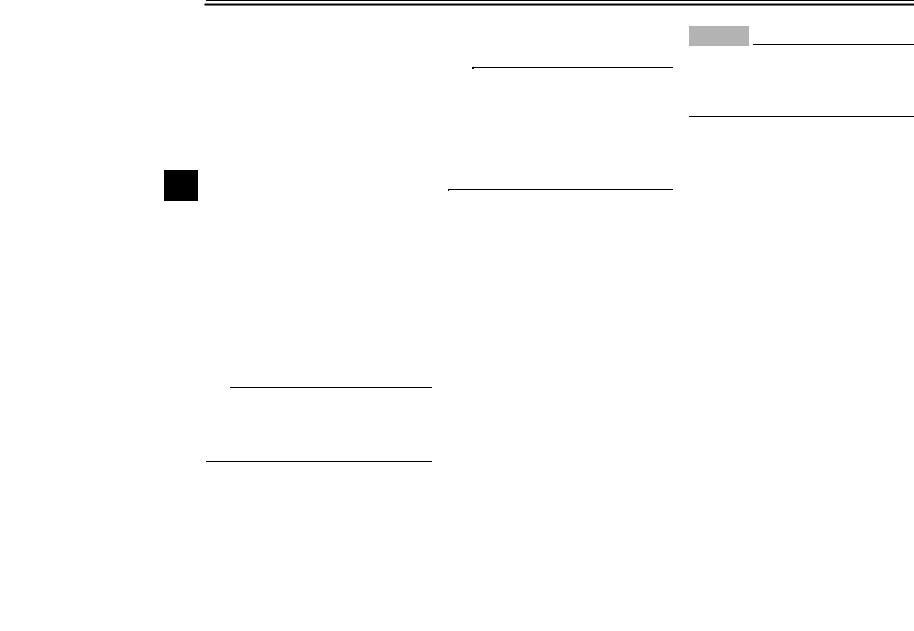
INSTRUMENT AND CONTROL FUNCTIONS
5.Push the “ ” or “
” or “ ” side of the “SELECT” switch to set the minutes.
” side of the “SELECT” switch to set the minutes.
6.Push the “RESET” switch and then release it to start the clock.
Self-diagnosis device
This model is equipped with a self-diag- nosis device for various electrical circuits.
4If a problem is detected in any of those circuits, the engine trouble warning light will come on and the odometer/tripmeter/clock display will indicate an error code.
The self-diagnosis device also detects problems in the immobilizer system circuits.
If a problem is detected in the immobilizer system circuits, the immobilizer system indicator light will flash and the display will indicate an error code.
TIP
If the display indicates error code 52, this could be caused by transponder interference. If this error code appears, try the following.
1.Use the code re-registering key to start the engine.
TIP
Make sure there are no other immobilizer keys close to the main switch, and do not keep more than one immobilizer key on the same key ring! Immobilizer system keys may cause signal interference, which may prevent the engine from starting.
2.If the engine starts, turn it off and try starting the engine with the standard keys.
3.If one or both of the standard keys do not start the engine, take the vehicle, the code re-registering key and both standard keys to a
Yamaha dealer and have the standard keys re-registered.
If the odometer/tripmeter/clock display indicates any error codes, note the code number, and then have a Yamaha dealer check the vehicle.
ECA11590
NOTICE
If the display indicates an error code, the vehicle should be checked as soon as possible in order to avoid engine damage.
Brightness control mode
1.Speedometer panel
2.Brightness level
This function allows you to adjust the brightness of the speedometer panel to suit the outside lighting conditions.
To set the brightness
1.Turn the key to “OFF”.
2.Push and hold the “ ” side of the “SELECT” switch.
” side of the “SELECT” switch.
4-8
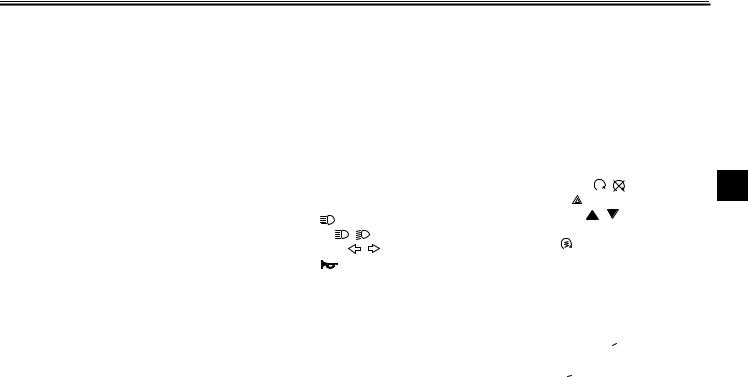
INSTRUMENT AND CONTROL FUNCTIONS
3.Turn the key to “ON”, and then release the “SELECT” switch after five seconds or more.
4.Push the “ ” or “
” or “ ” side of the “SELECT” switch to select the desired brightness level.
” side of the “SELECT” switch to select the desired brightness level.
5.Push the “RESET” switch to confirm the selected brightness level. The display will return to the odometer, tripmeter or clock mode.
EAU12347 Right
Handlebar switches
Left
|
|
|
|
1. |
Engine stop switch “ |
/ |
” |
4 |
|
|
|
|
|
2. |
Hazard switch “ |
” |
|
|
|
1. |
Pass switch “ |
” |
|
3. |
“SELECT” switch “ |
/ |
” |
|
|
|
4. |
“RESET” switch |
|
|
|
|
|||
2. |
Dimmer switch “ |
/ |
” |
|
|
|
|
||
5. |
Start switch “ |
” |
|
|
|
||||
3. |
Turn signal switch “ |
/ ” |
|
|
|
||||
|
|
|
|
|
|
||||
4. |
Horn switch “ |
” |
|
|
|
|
|
|
EAU12350 |
|
|
|
|
|
|
|
|
|
|
Pass switch “ ”
”
Press this switch to flash the headlight.
EAU12400
Dimmer switch “ /
/ ”
”
Set this switch to “ ” for the high beam and to “
” for the high beam and to “ ” for the low beam.
” for the low beam.
EAU12460
Turn signal switch “ /
/ ”
”
To signal a right-hand turn, push this switch to “ ”. To signal a left-hand turn, push this switch to “
”. To signal a left-hand turn, push this switch to “ ”. When released, the switch returns to the center
”. When released, the switch returns to the center
4-9
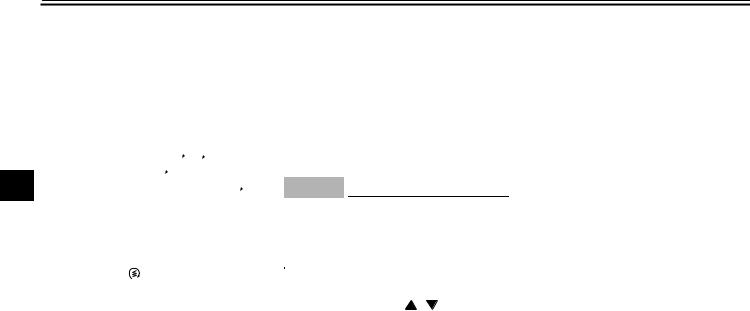
INSTRUMENT AND CONTROL FUNCTIONS
position. To cancel the turn signal lights, push the switch in after it has returned to the center position.
EAU12500
Horn switch “  ”
”
Press this switch to sound the horn.
EAU12660
Engine stop switch “ /
/ ”
”
Set this switch to “ ” before starting
” before starting
4the engine. Set this switch to “ ” to stop the engine in case of an emergency, such as when the vehicle overturns or when the throttle cable is stuck.
” to stop the engine in case of an emergency, such as when the vehicle overturns or when the throttle cable is stuck.
EAU12711
EAU12733
Hazard switch “ ”
”
With the key in the “ON” or “ ” position, use this switch to turn on the hazard lights (simultaneous flashing of all turn signal lights).
” position, use this switch to turn on the hazard lights (simultaneous flashing of all turn signal lights).
The hazard lights are used in case of an emergency or to warn other drivers when your vehicle is stopped where it might be a traffic hazard.
ECA10061
NOTICE
Do not use the hazard lights for an extended length of time with the engine not running, otherwise the battery may discharge.
EAU42532
“RESET” switch
This switch is used to perform selections in the tripmeter, to set the clock, and to set the brightness mode of the multi-function meter unit.
See “Multi-function meter unit” on page 4-6 for detailed information.
Start switch “ ” |
|
|
Push this switch to crank the engine |
EAU42523 |
|
with the starter. See page 6-1 for start- |
“SELECT” switch “ / ” |
|
ing instructions prior to starting the en- |
This switch is used to perform selec- |
|
gine. |
tions in the odometer, tripmeter, to set |
|
|
the clock, and to set the brightness |
|
EAU41700 |
mode of the multi-function meter unit. |
|
The engine trouble warning light will |
See “Multi-function meter unit” on page |
|
come on when the key is turned to “ON” |
||
4-6 for detailed information. |
||
and the start switch is pushed, but this |
||
|
||
does not indicate a malfunction. |
|
4-10

INSTRUMENT AND CONTROL FUNCTIONS
EAU12820
Clutch lever
1. Clutch lever
The clutch lever is located at the left handlebar grip. To disengage the clutch, pull the lever toward the handlebar grip. To engage the clutch, release the lever. The lever should be pulled rapidly and released slowly for smooth clutch operation.
The clutch lever is equipped with a clutch switch, which is part of the ignition circuit cut-off system. (See page 4-18.)
EAU12880
Shift pedal
1. Shift pedal
The shift pedal is located on the left side of the engine and is used in combination with the clutch lever when shifting the gears of the 5-speed con- stant-mesh transmission equipped on this motorcycle.
TIP
Use your toes or heel to shift up and your toes to shift down.
EAU12890
Brake lever
4
1. Brake lever
The brake lever is located at the right handlebar grip. To apply the front brake, pull the lever toward the handlebar grip.
4-11
